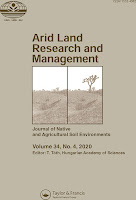A cikk hivatkozása az alábbi:
Varga, K., Csízi, I., Monori, I., Valkó, O. (2021): Threats and challenges related to grazing gardens: Recovery of extremely overgrazed grassland after grazing exclusion. Arid Land Research and Management doi: 10.1080/15324982.2020.1869120
A cikk összefoglalója az alábbiakban olvasható.
Abstract
Overgrazing causes serious problems for rangeland ecosystems and human livelihoods globally. Sheep grazing paddocks with fixed fences have become increasingly widespread in Europe; however, their effects on biodiversity have rarely been discussed. Our aim was to measure the degradation of grassland vegetation in an experimental sheep paddock in Central-Hungary, and evaluate recovery of alkali grasslands after the exclusion of grazing. We compared the vegetation of heavily overgrazed parcels to parcels excluded from overgrazing, treated with three doses of manure (0, 20 and 40t/ha), in the first three years of grassland recovery. The overgrazed parcels were dominated by nutrient-demanding ruderal plant species and the cover of target grassland species was only 19.8% in the third year. After grazing exclusion, the cover of target grassland species increased to 81.0% for Year 3. The dominant grass Festuca pseudovina became more abundant in the excluded parcels (51.1%) than in the overgrazed ones (8.9%). At the end of the experiment, the rate of degradation (0.2 vs. 3.7) and the cover-weighted ecological indicator values for nutrients (3.8 vs. 5.1) were significantly lower in the exclosures than in the overgrazed parcels. Manuring did not have a significant effect on grassland recovery; thus, it is not necessary in the studied ecosystem. We recommend avoiding grazing paddocks with fixed fence especially in areas harboring habitats of high conservation value. Besides resulting in the degradation of grasslands, grazing paddocks also act as landscape scars and propagule sources of problem species that might negatively affect the surrounding landscape.
 |
| Legelő juhok a Hortobágyon. Deák Balázs fotója. |

Nincsenek megjegyzések:
Megjegyzés küldése